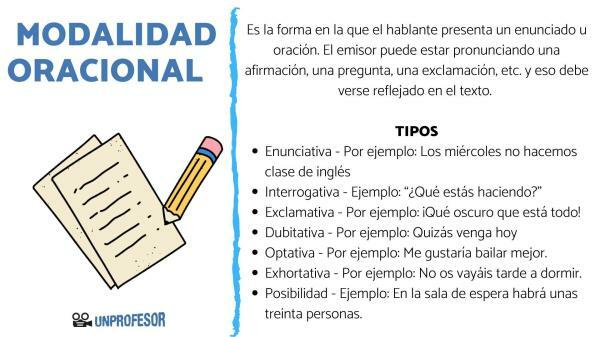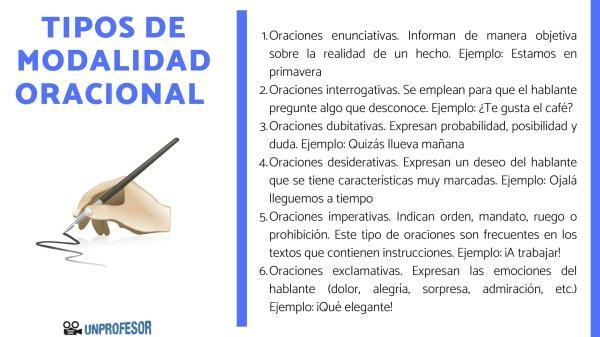Types of sentence modality

The sentences declarative, interrogative, doubtful, desiderative, imperative and exclamatory They are the different types of sentence modality.
Language is one of the most complex means of communication. that humanity possesses and sometimes we are able to underestimate it. But, the truth is that each of the words that come out of our mouths can have many connotations and meanings in the person who receives the message. The same happens with written language and the signs that help us set a tone for each of the sentences we write.
In this lesson from a PROFESSOR we are going to explain to you what are the types of sentence modality And what is each of them for? In this way you will be able to have a deeper knowledge of our language and write higher quality texts.
The sentence modality or also known as attitude or intention of the speaker it is the practical manifestation of language functions. This intention can be implicit in the language or be manifested explicitly, through the different resources such as gesture (in oral language), intonation, lexical symbols or grammatical marks that the language has.

Taking into account the grammatical elements that the language offers us to discover the intention of each one of the sentences, the following categories or types of sentence modality.
declarative sentences
The declarative sentences objectively report on the reality of a fact. This is the modality that we use most frequently and predominates in informative and scientific texts. It is characterized by presenting a descending intonation and by using the indicative mood of the verbs. This type of sentences can be affirmative (they present a content affirming it) or negative (they deny the content they report on).
For example:
- We are in spring
- This summer I will go to see you
- never comes
- I want nothing
- I have never seen anything like it
Interrogative sentences
The interrogative sentences They are used for the speaker to ask something that he does not know, while waiting for a response from the interlocutor. Its main characteristics are that it uses verbs of the indicative mood and that it uses the appellative function, waiting for a response from the other.
Depending on how the question is phrased, these can be direct interrogatives (they have a characteristic intonation in the oral environment and in writing it is manifested by signs and question marks), or indirect questions (they do not have intonation or visible signs).
For example:
- Did you go out with Luis?
- What book are you reading?
- I don't know where I'll go like this
- tell me which movie you like the most
- I don't know what I'll do without you
- Tell me if you love me
- Would you like to go to a movie?
- I wonder if you know
- How did you know?
- tell me where you found it
- Peter has called who?
- The concert starts when?
- Don't you have a tongue?
doubtful sentences
The doubtful sentences they express probability, possibility and doubt and take on different nuances depending on whether the content is close or far from reality. Its main characteristics are that they do not have a specific intonation, but they usually carry linguistic marks such as adverbs of doubt (maybe, perhaps, perhaps, etc.)
- maybe it will rain tomorrow
- I will probably go to Rome this summer
- Maybe they'll all come to the party
- could be very interesting
- it would be ten
- must be very smart
- It may not come back again
wishful sentences
The wishful sentences express a desire of the speaker that has very marked characteristics, such as intonation exclamative, verbs built in the subjunctive mode, the emotive function and grammatical marks like "hopefully". This wish is also shown in introductory verbs, such as "I wish that". The wishful sentences are classified, in turn, as potential (the realization of the wish is possible) or unreal (the fulfillment of the wish is impossible).
For example:
- I would like to get out of this situation
- I wish you don't get tired
- I hope we arrive on time
- I would like all the peace treaties in the world to be signed
- I wish I would have known in time
- Let the holidays arrive!
imperative sentences
The imperative sentences indicate order, mandate, request or prohibition. These types of sentences are frequent in texts that contain instructions. The main characteristics it presents is a descending tone that can be more or less abrupt, depending on the strength of the mandate. Its main objective is to achieve a certain behavior in the recipient and the imperative tense is used.
For example:
- To work!
- To dance!
- walking
- you shall not kill
- He will walk an hour a day
- let's get out of here quickly
- make me a duplicate please
- Do not come late
- Don't listen behind the door
- Would you like to serve me a coffee?
Exclamation sentences
The exclamation sentences are those that express the emotions of the speaker (pain, joy, surprise, admiration, etc.). characteristics, the intonation stands out, which is always intense and depends on the feelings of the listener. speaks. In written language it is manifested with exclamation marks. They do not have a characteristic verbal mode, since any of the modalities presented above can be pronounced as an exclamatory sentence.
For example:
- The occasion has arrived!
- If I had seen it before…!
- Come with me!
- How elegant!
- How I like it!

Perhaps you have already noticed in the previous section, but it is very important to pay attention to this general warning about the types of sentence modality.
The various sentence nuances are not excluded!
This means that the same sentence can be imperative and exclamatory or doubtful and interrogative at the same time. The chances that a sentence belongs to more than one modality they are very tall.
For example:
- A sentence can be negative and exclamatory at the same time: It is not possible!
- A sentence can adopt different tonalities depending on the modality to which it belongs: Are you coming?, or Are you coming!
Now you know what the types of sentence modality And what is each of them for? If you are interested in continuing to learn more about this topic or something similar, do not hesitate to consult our writing section, where we will give you all the advice you need to write some texts from 10.
Hidalgo Navarro, A. (2001). Sentence modality and intonation. Notes on the pragmatic functioning of suprasegmental features in conversation.
Alvarellos Pedrero, M. (2011). Influential melodic features in the discrimination of the sentence modality: the linguistic relevance of the pretoneme. Influential melodic features in the discrimination of the sentence modality, 1-150.



